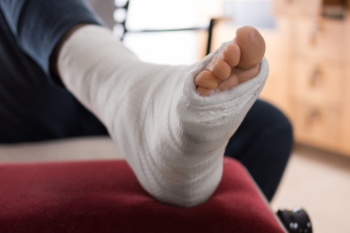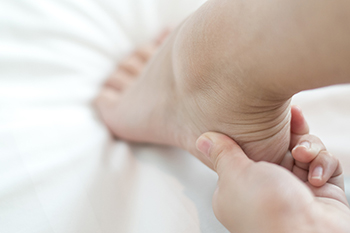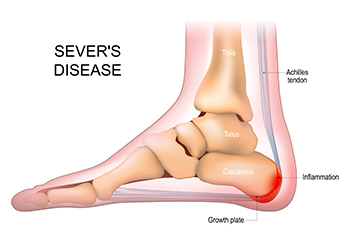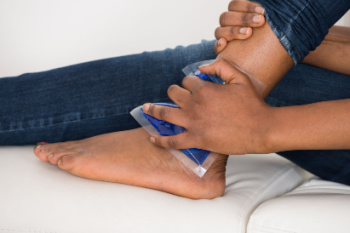Items filtered by date: May 2025
Understanding Lisfranc Injuries

Lisfranc injuries result if bones in the midfoot are broken or ligaments that support the midfoot are torn. The midfoot is key to foot stability and arch support. Injuries can result from trauma, such as a fall, car accident, or sports injury, even something as simple as twisting the foot awkwardly. Although rare, Lisfranc injuries are often mistaken for a simple sprain. Symptoms include swelling, bruising on the top and bottom of the foot, pain while standing or walking, and difficulty bearing weight. The foot may appear misaligned or feel unstable. Left untreated, a Lisfranc injury can lead to chronic pain, arthritis, and long-term disability. A podiatrist can diagnose a Lisfranc injury through a physical exam and imaging tests like X-rays, MRI or CT scans. Treatment depends on severity and may include rest, immobilization with a cast or boot, targeted exercises, or surgical repair to realign and stabilize the bones. If you think you may have this condition, it is suggested that you schedule an appointment with a podiatrist for appropriate treatment.
A broken foot requires immediate medical attention and treatment. If you need your feet checked, contact Judson Siegel, DPM from Assabet Family Podiatry. Our doctor can provide the care you need to keep you pain-free and on your feet.
Broken Foot Causes, Symptoms, and Treatment
A broken foot is caused by one of the bones in the foot typically breaking when bended, crushed, or stretched beyond its natural capabilities. Usually the location of the fracture indicates how the break occurred, whether it was through an object, fall, or any other type of injury.
Common Symptoms of Broken Feet:
- Bruising
- Pain
- Redness
- Swelling
- Blue in color
- Numbness
- Cold
- Misshapen
- Cuts
- Deformities
Those that suspect they have a broken foot shoot seek urgent medical attention where a medical professional could diagnose the severity.
Treatment for broken bones varies depending on the cause, severity and location. Some will require the use of splints, casts or crutches while others could even involve surgery to repair the broken bones. Personal care includes the use of ice and keeping the foot stabilized and elevated.
If you have any questions, please feel free to contact our offices located in Plainville, Marlborough, and Somerset, MA . We offer the newest diagnostic and treatment technologies for all your foot care needs.
Ankle Fracture? Don’t Wait for Treatment
Understanding Foot and Heel Pain in Children

Foot and heel pain in children is more common than many realize and can affect daily play, sports, and growth. One frequent cause is Sever’s disease, a condition linked to growing bones and tight tendons. Flat feet, overuse, wearing poor footwear, or injuries from running and jumping can also lead to discomfort. Children may limp, avoid activity, or complain of pain in the heel or arch. Pain may be worse in the morning or after exercise. Wearing supportive shoes, resting, and stretching can often bring relief. Custom orthotics may also help improve alignment and reduce strain. Children’s feet are still developing, so it is important to address pain early to avoid long-term problems. If your child often complains of sore feet or heels, it is suggested you see a podiatrist for an accurate diagnosis and appropriate treatment.
Making sure that your children maintain good foot health is very important as they grow. If you have any questions, contact Judson Siegel, DPM of Assabet Family Podiatry. Our doctor can provide the care you need to keep you pain-free and on your feet.
Keeping Children's Feet Healthy
Having healthy feet during childhood can help prevent medical problems later in life, namely in the back and legs. As children grow, their feet require different types of care. Here are some things to consider...
Although babies do not walk yet, it is still very important to take care of their feet.
Avoid putting tight shoes or socks on his or her feet.
Allow the baby to stretch and kick his or her feet to feel comfortable.
As a toddler, kids are now on the move and begin to develop differently. At this age, toddlers are getting a feel for walking, so don’t be alarmed if your toddler is unsteady or ‘walks funny’.
As your child gets older, it is important to teach them how to take care of their feet.
Show them proper hygiene to prevent infections such as fungus.
Be watchful for any pain or injury.
Have all injuries checked by a doctor as soon as possible.
Comfortable, protective shoes should always be worn, especially at play.
If you have any questions, please feel free to contact our offices located in Plainville, Marlborough, and Somerset, MA . We offer the newest diagnostic and treatment technologies for all your foot care needs.
Causes and Risk Factors of Sever’s Disease

Sever's disease, also known as calcaneal apophysitis, is a common cause of heel pain in growing children and adolescents. It occurs when the growth plate in the heel becomes inflamed due to repeated stress or tension from physical activity. This condition is most often seen in children who are active in sports that involve running and jumping. Risk factors include rapid growth spurts, participation in high-impact sports, and wearing shoes without proper support. Children with flat feet or high arches may also be more prone to this condition. Symptoms typically include heel pain during or after activity, tenderness at the back of the heel, and limping. If your active child has heel pain, it is suggested that you schedule an appointment with a podiatrist who can accurately diagnose and treat Sever’s disease.
Sever's disease often occurs in children and teens. If your child is experiencing foot or ankle pain, see Judson Siegel, DPM from Assabet Family Podiatry. Our doctor can treat your child’s foot and ankle needs.
Sever’s Disease
Sever’s disease is also known as calcaneal apophysitis, which is a medical condition that causes heel pain I none or both feet. The disease is known to affect children between the ages of 8 and 14.
Sever’s disease occurs when part of the child’s heel known as the growth plate (calcaneal epiphysis) is attached to the Achilles tendon. This area can suffer injury when the muscles and tendons of the growing foot do not keep pace with bone growth. Therefore, the constant pain which one experiences at the back of the heel will make the child unable to put any weight on the heel. The child is then forced to walk on their toes.
Symptoms
Acute pain – Pain associated with Sever’s disease is usually felt in the heel when the child engages in physical activity such as walking, jumping and or running.
Highly active – Children who are very active are among the most susceptible in experiencing Sever’s disease, because of the stress and tension placed on their feet.
If you have any questions, please feel free to contact our offices located in Plainville, Marlborough, and Somerset, MA . We offer the newest diagnostic and treatment technologies for all your foot care needs.
Caring for Ankle Pain the Right Way

Ankle pain can result from a sudden injury, overuse, or an underlying condition like arthritis or tendonitis. Resting the ankle and avoiding activities that cause strain are important first steps. Elevating the foot can help reduce swelling and ease discomfort. Gentle movement and stretching, once the pain begins to subside, may support recovery, but pushing through pain can worsen the injury. Wearing stable, supportive shoes instead of sandals or heels can also help protect the joint. Avoid wrapping the ankle too tightly, which can cut off circulation. If the pain is sharp, persistent, or accompanied by swelling, bruising, or instability, it may indicate a fracture or torn ligament. Early evaluation can prevent long-term complications and improper healing. If your ankle pain does not improve or interferes with walking, it is suggested that you see a podiatrist for a proper diagnosis and appropriate treatment.
Ankle pain can have many different causes and the pain may potentially be serious. If you have ankle pain, consult with Judson Siegel, DPM from Assabet Family Podiatry. Our doctor will assess your condition and provide you with quality foot and ankle treatment.
Ankle pain is any condition that causes pain in the ankle. Due to the fact that the ankle consists of tendons, muscles, bones, and ligaments, ankle pain can come from a number of different conditions.
Causes
The most common causes of ankle pain include:
- Types of arthritis (rheumatoid, osteoarthritis, and gout)
- Ankle sprains
- Broken ankles
- Achilles tendinitis
- Achilles tendon rupture
- Stress fractures
- Tarsal tunnel syndrome
- Plantar fasciitis
Symptoms
Symptoms of ankle injury vary based upon the condition. Pain may include general pain and discomfort, swelling, aching, redness, bruising, burning or stabbing sensations, and/or loss of sensation.
Diagnosis
Due to the wide variety of potential causes of ankle pain, podiatrists will utilize a number of different methods to properly diagnose ankle pain. This can include asking for personal and family medical histories and of any recent injuries. Further diagnosis may include sensation tests, a physical examination, and potentially x-rays or other imaging tests.
Treatment
Just as the range of causes varies widely, so do treatments. Some more common treatments are rest, ice packs, keeping pressure off the foot, orthotics and braces, medication for inflammation and pain, and surgery.
If you have any questions please feel free to contact our offices located in Plainville, Marlborough, and Somerset, MA . We offer the newest diagnostic tools and technology to treat your foot and ankle needs.

